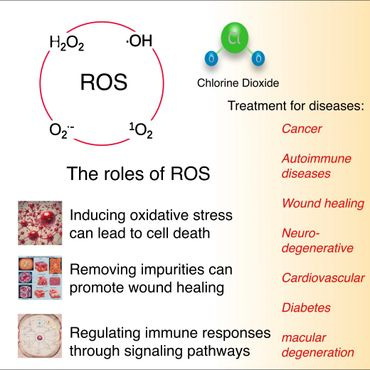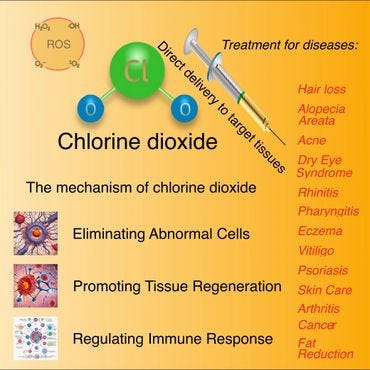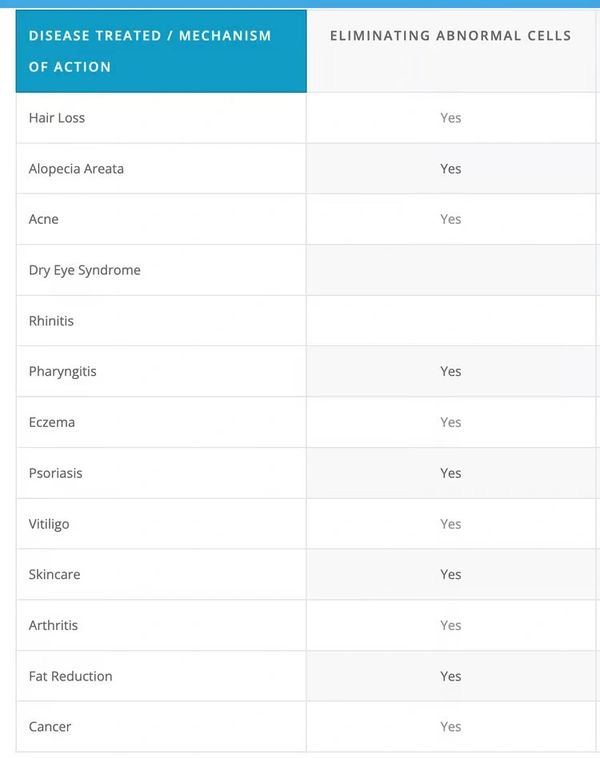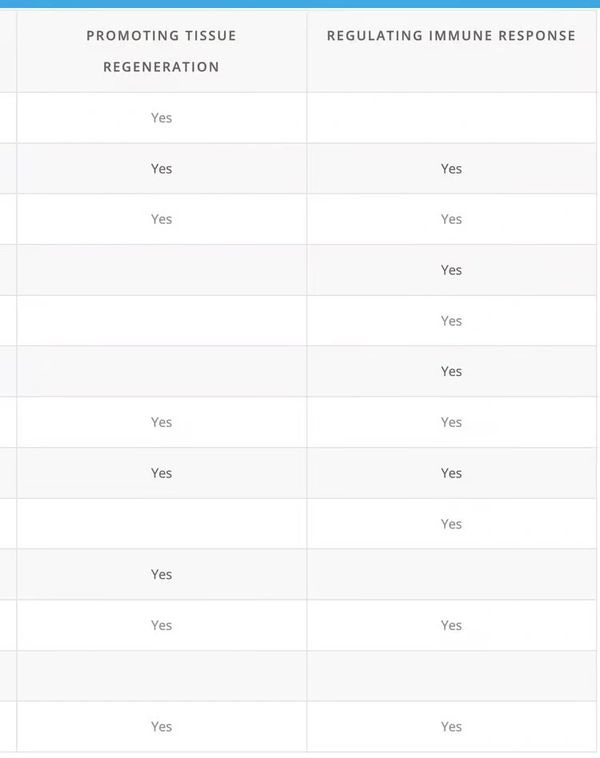Why I Recommend Chlorine Dioxide for Self-Treatment, Especially for Advanced Cancer Patients, and Particularly Those with Late-Stage Breast Cancer(Part 1)
The Limitations of Modern Medicine: Why Almost Everyone Has a Motive to Seek Alternative Treatments Like Chlorine Dioxide
Modern Healthcare System Only Achieves 10% Cure Rate, While Chlorine Dioxide Can Cure 50% of Diseases
Illness is a part of life, but curing is not always guaranteed. In China, one in every ten individuals suffers from diabetes, with one in four having high blood pressure. There's a 22% chance of encountering cancer in one's lifetime. Cancer remains unconquered, chronic diseases like hypertension require lifelong medication, and even common ailments like the flu are combated by the body's immune system rather than solely by human-made drugs.
According to the World Health Organization, there are currently 55,000 known diseases. Broadly categorized, human diseases fall into the following major groups:
Infectious diseases
Parasitic diseases
Malignant tumors
Benign tumors
Endocrine disorders (nutritional and metabolic diseases, as well as immune disorders)
Blood and hematopoietic organ diseases
Mental illnesses
Neurological diseases
Eye and adnexal diseases
Ear and mastoid diseases
Diseases of the circulatory system
Respiratory system diseases
Digestive system diseases
Genitourinary system diseases
Pregnancy, childbirth, and puerperium complications
Skin and subcutaneous tissue diseases
Musculoskeletal system and connective tissue diseases
Injuries and poisonings
I prefer categorizing diseases based on their pathogens.
Based on pathogens, human diseases fall into two major categories:
Infectious diseases
Pathogens include viruses, rickettsiae, bacteria, fungi, protozoa, helminths, arthropods, and more. Since pathogens can replicate, they can spread from one host to another through various means, causing the same disease in the new host. These are known as infectious diseases or simply infections. When such diseases spread widely among populations, they are referred to as epidemics. Severe infectious diseases can lead to large-scale fatalities. In developed countries, infectious diseases account for less than 1% of deaths, around 5% in China.
Non-infectious diseases
With the gradual control of infectious diseases, the relative harm of non-infectious diseases has increased. Tumors, coronary heart disease, and strokes fall under this category. In major cities in China and developed countries, these diseases rank among the top three causes of death. Diseases can be classified according to the following causes.
1. Genetic diseases. Diseases caused by genetic alterations before or during the formation of the fertilized egg.
2. Physical and chemical injuries.
- Chemical injuries can be acute, such as poisoning or burns, with immediate effects and clear causes. They can also be chronic, taking years or even generations to manifest, requiring investigation to reveal the cause. Chronic poisoning can occur naturally, like excessive fluoride in drinking water causing dental fluorosis or affecting bone growth, leading to skeletal fluorosis. However, many diseases are human-made, including occupational and environmental diseases like silicosis, Minamata disease caused by organic mercury poisoning, and itai-itai disease caused by cadmium poisoning. Many drug-induced diseases are also a form of chemical injury. The damage from some chemicals can manifest in the next generation; for instance, thalidomide causing phocomelia (limb malformation) is a well-known example. Early pregnancy intake of estrogen-like drugs can lead to vaginal cancer in the next generation when the girls are in their teens.
3. Diseases caused by physical factors like frostbite, burns, electric shock injuries, radiation damage, altitude sickness, decompression sickness, and adverse effects of noise on hearing and blood pressure are well-known. The widespread use of technologies like telegraphy, telephony, broadcasting, television, and radar has exposed modern humans of all ages and genders to various electromagnetic waves, posing new environmental challenges. The impact of these waves on human survival and reproduction remains a topic for exploration.
4. Immune-related diseases. Diseases caused by immune system dysregulation, which can be divided into two categories: an excessive reaction to certain external or environmental antigens, and the immune system mistakenly targeting the body's own tissues or cells, known as "autoimmunity."
5. Abnormal cell growth. One of the leading causes of death. Unusual cell growth is referred to as hyperplasia. During hyperplasia, cell morphology remains unchanged and retains its original functionality. For example, thyroid cell hyperplasia can lead to an enlarged thyroid gland, excessive thyroid hormone secretion, and hyperthyroidism. Generally, hyperplasia is triggered by hormones or chronic stimulation. The proliferation of normal cells in the human body has a certain limit, after which it stops. When the regulatory mechanism of proliferation weakens, cell hyperplasia occurs; the complete loss of this regulatory mechanism leads to tumors.
6. Metabolic and endocrine diseases.
7. Nutritional diseases. Including malnutrition and diseases due to overnutrition.
8. Psychogenic diseases, or mental disorders. Most individuals will experience some form of psychogenic disease. According to statistics, one in every two hospitalized patients in the United States is affected by psychogenic diseases. These can be categorized into organic and non-organic types. Organic psychogenic diseases show a clear genetic tendency, especially schizophrenia, often with a family history. Some genetic diseases also exhibit intellectual disabilities, such as congenital idiocy, Huntington's chorea, and phenylketonuria. Infectious diseases, especially late-stage syphilis, can affect the brain, leading to psychiatric symptoms. Drugs and certain chemicals (such as lead and corticosteroids) often cause psychiatric symptoms. Nutritional deficiencies like folate and vitamin B12 deficiency can lead to pernicious anemia accompanied by psychiatric symptoms. Children growing up in starvation conditions may also experience developmental delays. Severe illnesses can induce psychological stress, resulting in depressive symptoms. Non-organic psychogenic diseases manifest as mental symptoms due to life stressors. Anxiety and depression are the most common symptoms. Symptoms of non-organic psychogenic diseases can affect every system in the body and may be confused with any organic disease, leading to psychosomatic illnesses.
9. Geriatric diseases. It's difficult to draw a clear line between the normal degradation associated with aging and the degeneration caused by age-related diseases. The most common issues among the elderly involve the heart, blood vessels, and joints. With reduced resistance, older individuals are more prone to infections and injuries.
Among these nine categories of diseases, only a few infectious diseases and nutritional diseases can be considered curable through medical interventions. For the remaining 95% of major disease categories, there is no cure, not even relief in most cases. Overall, 90% of human diseases are currently incurable.
Therefore, I assert that modern medicine is one of the most backward disciplines for humans, where the value generated by the providers in the medical system comprising numerous experts is far lower than the income they derive from this system.
This is why many people seek alternative therapies or engage in self-treatment outside the modern medical system.
Three Mechanisms of Chlorine Dioxide in Disease Treatment: Facilitating Cellular Clearance, Promoting Regeneration, and Modulating Immune Responses at the Site of Lesions, with a Mechanism Analogous to Reactive Oxygen Species (ROS).
Met-min(refers to a very common type 2 diabetes medication) is a well-studied drug that is primarily used for the treatment of type 2 diabetes. However, research has also suggested potential benefits of met-min beyond its anti-diabetic effects. These include weight loss, cancer prevention, and potential anti-aging effects.
There are conflicting reports regarding the impact of met-min on Reactive Oxygen Species (ROS)levels in the body. Some studies suggest that met-min may increase ROS levels, while others suggest that it helps reduce ROS and oxidative stress damage.
ROS, as a signaling molecule, has been extensively studied and is known to play a role in clearing abnormal cells, promoting tissue regeneration, and regulating immune responses.
Speculation suggests that supplementing chlorine dioxide at lesion sites may have similar effects by potentially clearing abnormal cells, promoting tissue regeneration, and regulating the immune system.
Three key mechanisms of chlorine dioxide
1. THE NON-SELECTIVE CELL ELIMINATION MECHANISM OF CHLORINE DIOXIDE
Chlorine dioxide, as a potent oxidant, can kill a wide range of viruses, bacteria, and parasites at certain concentrations. This implies that chlorine dioxide can eliminate cells indiscriminately when delivered to any part of the body.
The non-selective cell elimination mechanism of chlorine dioxide is important in treating proliferative diseases like senescent diseases and cancer. By delivering chlorine dioxide directly to the affected area, it can effectively clear out damaged cells by indiscriminately killing them on contact. Although some normal cells may be harmed, the body can replace them with healthy cells.
The non-selective nature of chlorine dioxide in cell elimination is crucial because the body struggles to regenerate cells to fill the voids left by damaged cells. For example, in conditions like androgenetic alopecia, where hair follicles age and fall out, the space is usually not replaced by new follicles of the same size, but by smaller ones or surrounding sebaceous gland cells. To treat hair loss, it is necessary to clear the normal sebaceous gland cells that have taken over the space originally belonging to the hair follicles. The non-selective cell clearance mechanism of chlorine dioxide provides a foundation for addressing hair loss.
In cancer treatment, drug resistance is a significant challenge. Many existing drugs target specific cancer cell markers or pathways, making them ineffective against the diverse nature of cancer cells. However, if there were a drug capable of effectively destroying any type of cancer cell, regardless of mutations or heterogeneity, it could eliminate cancer cells indiscriminately. By directly injecting chlorine dioxide into tumors, continuous elimination of cancer cells may be possible, potentially transforming cancer into a manageable chronic condition and sparing patients from drug resistance issues.
2. THE MECHANISM OF CHLORINE DIOXIDE IN PROMOTING TISSUE REGENERATION
Existing research has demonstrated that the exogenous supplementation of ROS can promote tissue regeneration. We are now using chlorine dioxide to mimic the role of ROS, giving us reason to believe that the direct delivery of chlorine dioxide can enhance tissue regeneration.
The potential reasons for chlorine dioxide’s promotion of tissue regeneration could be related to the following three aspects:
Chlorine dioxide acts as an antimicrobial agent, protecting the wound from microbial infections.
As an oxidant, chlorine dioxide effectively clears away scabs or proliferating connective tissue at the wound site.
Chlorine dioxide may mimic the role of ROS, modulating the immune system and reducing inflammatory responses, thus facilitating normal tissue regeneration.
The mechanism by which chlorine dioxide promotes tissue regeneration is crucial for treating various diseases. Particularly when chlorine dioxide is delivered directly to the affected area, it can swiftly eliminate cells within and around the target zone. Once the clearance process is complete, it leaves behind spaces that need to be filled with regenerated healthy cells. Thus, chlorine dioxide not only enhances tissue regeneration but also strengthens its cell-clearing action, collectively aiding the recovery process from diseases.
3. THE MECHANISM OF IMMUNE RESPONSE REGULATION BY CHLORINE DIOXIDE
Maintaining a balanced immune system is crucial. An excessively strong immune response can trigger autoimmune diseases, for which effective treatments are currently lacking. On the other hand, a weakened immune response increases the risk of cancer and other age-related diseases, which pose significant treatment challenges.
While there is some controversy in research findings, certain studies suggest that increasing levels of reactive oxygen species (ROS) in the body may help suppress excessive immune responses and reduce inflammation. For example, met-min can inhibit inflammation by increasing ROS levels, potentially alleviating autoimmune diseases. Furthermore, there is conclusive evidence that tumor ablation therapies like Photodynamic Therapy (PDT) generate ROS, triggering systemic antitumor immune responses and inhibiting tumor growth in other parts of the body.
These studies indicate that ROS plays a bidirectional role in regulating immune responses. Based on this, we can speculate that chlorine dioxide might mimic the function of ROS. When directly delivered to the affected area, chlorine dioxide could modulate the immune response, suppressing inflammation in inflammatory diseases and eliciting systemic antitumor immune responses in cancer therapy.
Under my guidance, many individuals have tried using topical chlorine dioxide to treat various autoimmune skin diseases, achieving remarkable results. Some have even experienced complete resolution of skin issues such as alopecia areata, eczema, psoriasis, and vitiligo. Additionally, in my personal experiments, I successfully treated my arthritis by injecting a high-concentration chlorine dioxide solution (15mg/mL) directly into the joint cavity ten times. These experiences demonstrate chlorine dioxide’s ability to suppress inflammatory responses.
In another study, I treated cancer by injecting chlorine dioxide directly into tumors, which showed that this approach could stimulate a systemic immune response, effectively inhibiting tumors in other parts of the body that were not directly injected. This further confirms chlorine dioxide’s potential to modulate the immune system.
Disease Treated / Mechanism of Action Table with Chlorine Dioxide
The book presents 13 treatment protocols for various conditions, including hair loss, alopecia areata, acne, dry eye syndrome, rhinitis, pharyngitis, eczema, psoriasis, vitiligo, skincare, arthritis, cancer, and localized fat reduction.
Over the years of researching chlorine dioxide, I have developed methods for curing autoimmune diseases, cancer, and age-related diseases, accounting for nearly 50% of all human diseases.










This is awesome. Dealing with RA and inflammation behind the eyes as well. My hands are twisted and can feel it in my back and shoulders, feet today. Praying it's not too late! Thank you for the post!!